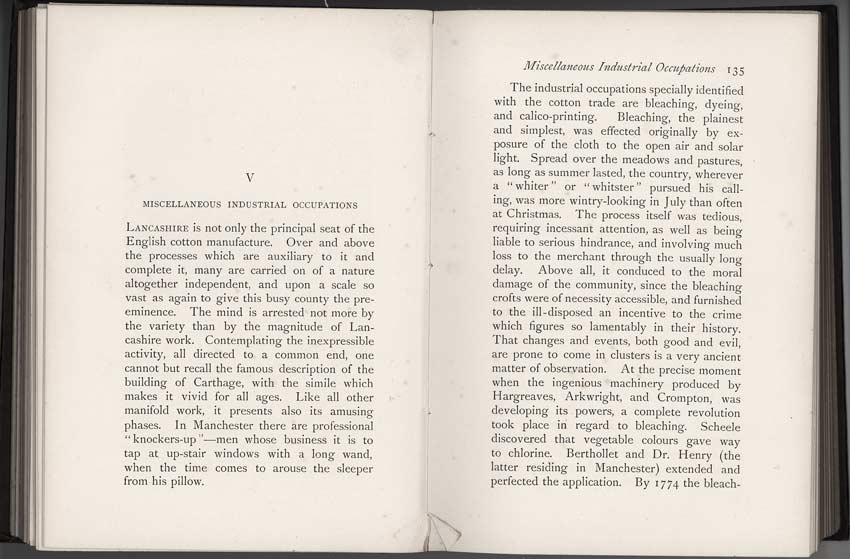
Scan and page transcript from:
LANCASHIRE - Brief Historical and Descriptive Notes
by Leo H. Grindon
Pub. 1892
pages 134-135 |
MISCELLANEOUS INDUSTRIAL OCCUPATIONS LANCASHIRE is not only the principal seat of the English cotton manufacture. Over and above the processes which are auxiliary to it and complete it, many are carried on of a nature altogether independent, and upon a scale so vast as again to give this busy county the pre-eminence. The mind is arrested not more by the variety than by the magnitude of Lancashire work. Contemplating the inexpressible activity, all directed to a common end, one cannot but recall the famous description of the building of Carthage, with the simile which makes it vivid for all ages. Like all other manifold work, it presents also its amusing phases. In Manchester there are professional "knockers-up" - ·men whose business it is to tap at upstair windows with a long wand, when the time comes to arouse the sleeper from his pillow. |
Miscellaneous Industrial Occupations 135 The industrial occupations specially identified with the cotton trade are bleaching, dyeing, and calico-printing. Bleaching, the plainest and simplest, was effected originally by exposure of the cloth to the open air and solar light. Spread over the meadows and pastures, as long as summer lasted, the country, wherever a "whiter" or "whitster" pursued his calling, was more wintry-looking in July than often at Christmas. The process itself ywas tedious, requiring incessant attention, as well as being liable to serious hindrance, and involving much loss to the merchant through the usually long delay. Above all, it conduced to the moral damage of the community, since the bleaching crofts were of necessity accessible, and furnished to the ill-disposed an incentive to the crime which figures so lamentably in their history. That changes and events, both good and evil, are prone to come in clusters is a very ancient matter of observation. At the precise moment when the ingenious machinery produced by Hargreaves, Arkwright, and Crompton, was developing its powers, a complete revolution took place in regard to bleaching. Scheele discovered that vegetable colours gave way to chlorine. Berthollet and Dr. Henry (the latter residing in Manchester) extended and perfected the application. By 1774 the bleach- |
